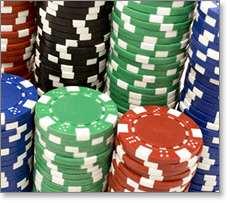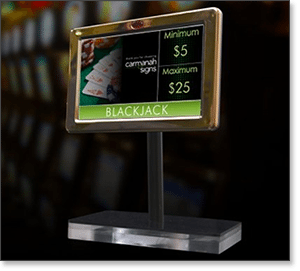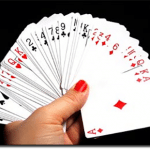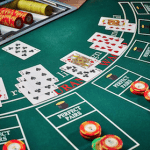 Whether you play blackjack in a private game or at brick and mortar casinos, money management is every bit as important as understanding the rules of 21 and how to apply proper strategy. If you don’t know how to look after your bankroll, then all the blackjack knowledge in the world isn’t going to save you – especially when the cards aren’t falling your way.
Whether you play blackjack in a private game or at brick and mortar casinos, money management is every bit as important as understanding the rules of 21 and how to apply proper strategy. If you don’t know how to look after your bankroll, then all the blackjack knowledge in the world isn’t going to save you – especially when the cards aren’t falling your way.
Let’s be clear: we are not talking about magical betting strategies that will guarantee long-term profits. This is about planning your blackjack sessions in advance and setting up absolute boundaries before you play a single hand. Figuring out when to press, when to pull back, and when to call it quits is the key to making your stack last longer.
If you are a casual punter who plays every so often for fun and with no real expectation of making a quid, this information isn’t really required – go out and enjoy yourself. However, if you have taken the time to learn basic strategy and want to start putting that know-how to work at the blackjack tables, these bankroll tips should serve you well.
What is a Bankroll?
Simply put, a bankroll is the money you set aside exclusively for gambling. This should only consist of disposable income – fun money, entertainment expenses, whatever you want to call it. This is cash that you have already written off, in essence, and which will not be too sorely missed if it should be gobbled up by the casino.
Your blackjack bankroll should not, under any circumstances, include funds required for day-to-day living costs. Never dodge the electricity bill just so you can squeeze in a few hands at the local casino. Gambling with cash that should be designated for essentials will put you out on the street before you can say “destitute”.
So here’s our first bankroll management tip: if you can’t afford to lose it, then you can’t afford to play. It’s that simple.
Know When to Quit – Set a Stop Loss
For all the arcane knowledge and strategic mastery one may possess, there is no solution for rotten bad luck. Some days you will be dealt junk after rubbish after trash from the moment you sit down, and there is absolutely nothing you can do about it. That’s just how games of chance work – you win some, you lose some.
Thus, it is crucial that you predetermine the maximum amount of cash you are prepared to forfeit during a betting session. This figure is called a stop loss. The exact amount is entirely up to the individual, as well as the total size of his/her bankroll. A player with $1000 to spend might be prepared to part with $500, while someone with $300 may be happy to risk all of it.
At the other end of the spectrum, you should also consider the minimum amount you would like to win. This is not to say you can’t keep betting once you reach that number; rather, it is the stop loss should your luck turn for the worse once you exceed that figure.
For example: let’s say we are on a $10 minimum bet table and we are happy to walk away $100 up. The cards are falling nicely, we get on a roll, and soon we are $150 up. Then the deck cools off and we concede four $10 bets on the trot. If we were to make the same wager on the next hand and lose, we would be back to $100 – at which point we should take the money and run.
When you’re up, you can always be a bit more flexible and let your intuition guide you to some degree. If your cut-off is $100 and you are up $150, there is no reason you can’t call it a day right there. When you are down, however, you have to be firm. As soon as you reach your stop loss, get the hell out of there.
Choose the Right Table Limits
Once you have determined the size of your bankroll and how much of it you are prepared to risk, it is time to pick a real money blackjack game that will suit your needs. The important thing here is to choose a table that will allow you to hang around if you walk straight into a cold deck – that is, when the cards are favouring the house.
 If you are serious about stretching your Aussie dollar as far as it can go, a good rule of thumb is to buy-in with at least 50 times the minimum bet. So if you are looking at a $10 minimum wager, you should bring at least $500 to the table; if the lowest bet allowed is $100, you should buy-in with $5000 or more; and so on and so forth.
If you are serious about stretching your Aussie dollar as far as it can go, a good rule of thumb is to buy-in with at least 50 times the minimum bet. So if you are looking at a $10 minimum wager, you should bring at least $500 to the table; if the lowest bet allowed is $100, you should buy-in with $5000 or more; and so on and so forth.
At most land-based Australian casinos, the blackjack and pontoon tables start at $5 – so you would need at least $250 to cover your arse in the event of a cold snap. If you don’t have $250 in the kitty, then go home, save up your ducats, and come back another time when you can afford it.
Never Trust a Betting System
Q: Is there a blackjack betting strategy that guarantees success?
A: Nope.
There is not a single shred of evidence to support the notion that any wagering system can increase your chances of winning at 21. Many gullible players and so-called “experts” swear by them, but all those claims that such-and-such a betting plan can ensure big earnings while minimising losses are – if you will excuse our French – utter bollocks.
Here’s a stone cold fact: there is no betting technique that can reduce the house edge. In fact, some of the most popular blackjack systems can drastically increase your chances of running up huge deficits. This is particularly true of negative progressions like the Martingale, where you double your stake after every loss. All it takes is a few bad hands in a row, and you’re up against the maximum bet limit with no place left to go.
That is not to say betting strategies are completely useless. Systems like the D’Alembert strategy, the Labouchere strategy, and Oscar’s Grind act almost as a game within a game, which appeals to punters who find that simple bet progressions keep them sharp during long sessions at the table. Whatever floats your boat, we say.
But for the love of Jebus and all that is holy, we insist on one golden rule: never, EVER pay for a blackjack strategy. There are scam artists all over the Web trying to fleece novices and desperate folks with “secret systems” that will break the bank and make you a millionaire. Ignore them all. These are the same old tried-and-untrue betting patterns that have been around for decades, so don’t even think about it.
Avoid the Side Bets
All blackjack side bets are for suckers. The rewards might be alluring at first glance, but do the maths and you will see just how bad some of these wagers really are. Here are a few popular ones:
Perfect Pairs – house edge 11.8% on Crown Pontoon
Super Sevens – house edge 11.4% at Treasury Casino
Lucky Ladies – house edge 16.7% minimum
If you are feeling especially lucky for some mystical, undefinable reason, we will forgive you for throwing a cheeky buck or two on a one-off side wager. But if you play these appalling bets with any regularity at all, you might as well be setting your pay cheque on fire.
Play Real Cash Blackjack Online
Our top tip for blackjack money management? Skip the b&m gaming venues altogether and play Internet 21 instead. Besides the overwhelming convenience of winning real money from home, playing online blackjack cuts out many of the expenses that can eat into your gambling bankroll. There’s no insane taxi fares or fuel costs, no overpriced food and drink, and most Web-based 21 titles offer a far greater expected return (up to 99.9%) than land based casino blackjack. Add in a greater range of bet limits, and your hard-earned coin just goes that much further.
And here’s the best part: when you sign up at one of our recommended online casinos, the house will fill your account with bonus cash. Just register online, make a deposit using one of the many secure banking methods, and you can claim hundreds, even thousands of dollars in free betting credits. This means the casino will actually fund your blackjack bankroll – a service you certainly won’t get when you walk into a real life casino.



